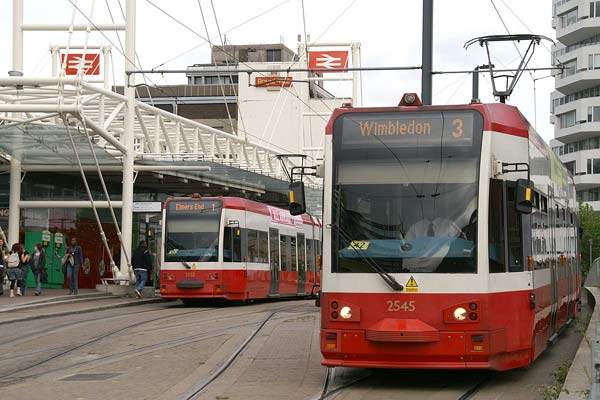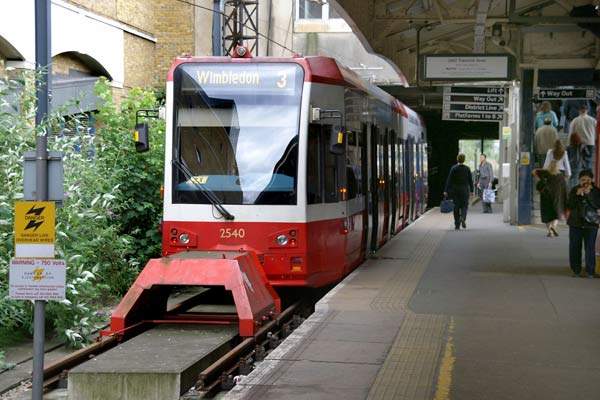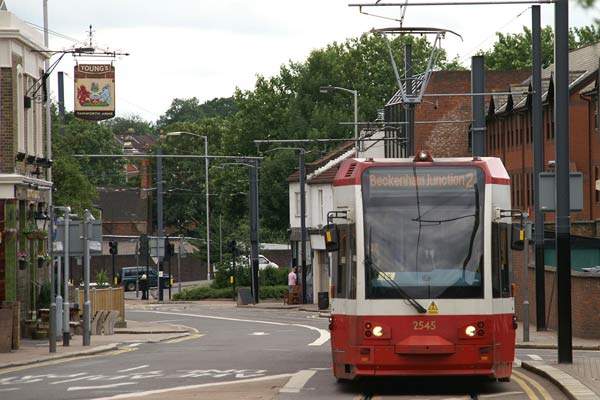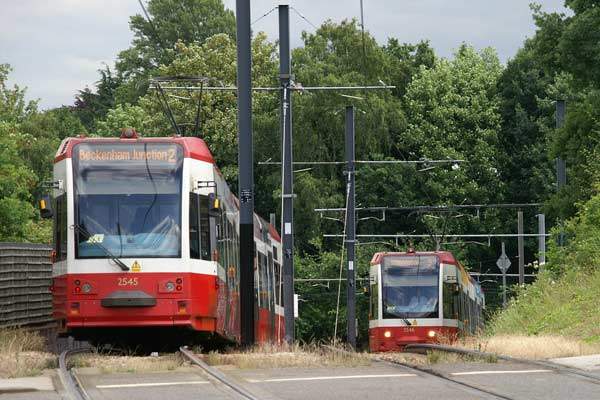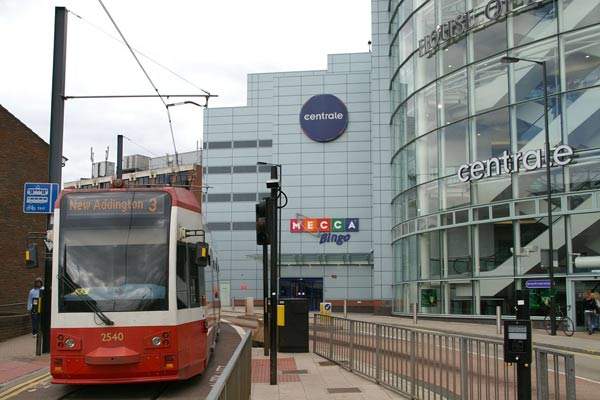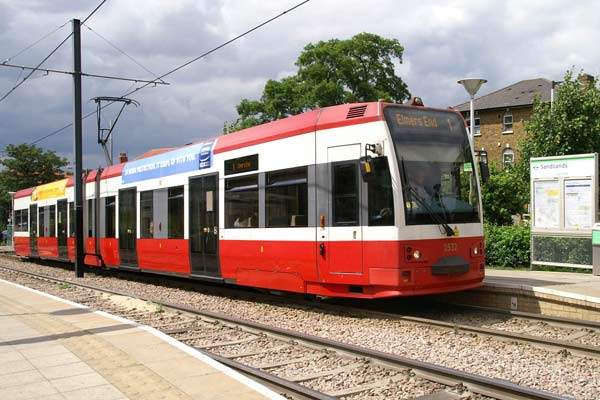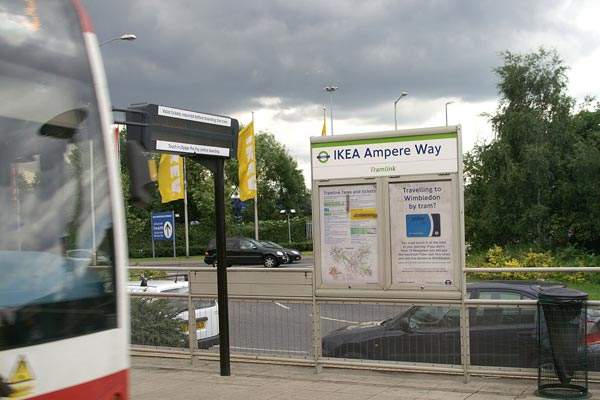Croydon is part of the London conurbation, 15 miles south of the capital’s centre. The most populous London borough with a population over 330,000, due to its proximity to central London and own concentration of commercial property, Croydon has heavy outward and inward commuter traffic.
The decision to create a modern tramway reflected the failure of the capital’s transport infrastructure to adequately serve this centre within the metropolitan area. Croydon Tramlink mirrors the revival of urban light rail in Paris in that it caters for journey demand not being provided for by a predominantly radial pattern of heavy rail services.
The project
Bringing trams back to Greater London, 50 years after the traditional system had been abandoned, evolved from discussions in the 1980s between the former national mainline operator British Rail and London Transport. Heavy rail routes radiate from central London termini (the Brighton Line passing through Croydon), but unlike in north London, the south had minimal coverage by the Underground system.
A 1991 public consultation showed over 80% of respondents in favour of the Tramlink project. Formal approval to create the system was given under the Croydon Tramlink Act in July 1994.
The concession bid winner to design, finance, build and operate under a 99-year lease was Tramtrack Croydon Limited (TCL). The consortium comprised CentreWest Limited (part of First Group), Sir Robert McAlpine Limited, Amey Construction, Royal Bank of Scotland and Bombardier Transportation.
Of the £200m project cost, TCL contributed £75m, with the central government covering the remainder in view of the general significance for London.
In 2000, Transport for London (TfL) was created as the integrated body responsible for London’s transport system, thereby inheriting responsibility for the TCL Private Finance Initiative contract. In 2006-07, TfL paid £4m to TCL in compensation for changes of fare arrangements, an amount expected to increase through the contract’s life.
Infrastructure
Construction began in January 1997, the 28km system becoming operational in May 2000 with 38 stops. After a protracted funding dispute, a stop to serve a large shopping and entertainment centre of the same name, Centrale, opened in December 2005. Also connected with a retail outlet, an original stop name was modified to IKEA Ampere Way in 2006.
The 1,435mm gauge system uses a combination of dedicated track (which includes 18km of former heavy rail routes and shared alignment), mixed street running and reserved track on streets. There are sections of single, double and interlaced gauntlet track.
The maintenance depot is at Therapia Lane between Croydon and Wimbledon. As revised in 2006, Tramlink operates as three routes, all serving central Croydon:
- Line 1: Elmers End-Croydon
- Line 2: Beckenham Junction-Croydon
- Line 3: New Addington-Croydon-Wimbledon
TfL bus services connect with Tramlink in many places, and three of the four system termini are at heavy rail stations, these including Wimbledon which also connects with the London Underground. The busiest rail interchange is in the town centre at East Croydon station on the London Victoria-Gatwick Airport-Brighton and ‘Thameslink’ lines. In 2007 Tramlink carried 27 million passengers.
Rolling stock
Bombardier built the 24 CR4000 trams in Vienna at a cost of £35m, including a maintenance agreement. Retrospectively classified in the Flexity Swift family, they were based upon the successful K4000 series as used in Cologne, Germany.
The 76% low-floor CR4000 has electrical and traction equipment supplied by Vossloh-Kiepe. They consist of two long car bodies, each with a motor bogie at the driving end. The bodies are connected by a short section on a trailer bogie. To meet the system’s configuration, the CR4000 is bi-directional with doors on both sides.
Two areas per unit are available for disabled passengers or those with prams or bicycles. Each CR4000 can carry 209 passengers, 74 seated and 135 standing. Top speed is 80kmh (50mph). Equipment includes automatic load detection, anti-slip devices, brake force control and an electronic diagnostic system.
Concern over vandalism, safety and security led to CCTV cameras being fitted, two external and four internal. During 2007 dissatisfaction was made public by the Mayor of London about TCL’s level of service on the system. Concerns about the relationship between parties in the Tramlink operation were also raised in a report on a 2006 derailment.
Signalling and communications
Tram stops have a shelter with integrated passenger information and help points connected to the Therapia Lane control room. There are CCTV cameras at each stop and elsewhere covering the routes.
On street-running sections, LCD route indicators show when a tram has permission to proceed. Elsewhere the signalling is a development of the multiple aspect system used on UK heavy rail.
Modifications have included LED display destination indicators and pre-recorded next stop announcements controlled via a GPS system. The system is represented on National Rail London Connections maps and ticketing includes the Oyster card, bus passes and Travelcards.
The future
TfL identifies four potential system extensions: Sutton to Wimbledon; Sutton to Tooting; Streatham to Purley; and Crystal Palace to Beckenham Junction/Croydon. With an option of three routes and an intended six trams per hour in each direction, the Crystal Palace project received funding for development in 2004.
Subject to funding approval, the four-station 3km extension from the present line at the Harrington Road stop is projected to open by 2013.
Assuming the public-preferred station route option is chosen, by 2013 there should be a connection at Crystal Palace station with the extended East London Line, a TfL operation running under the London Overground identity.
In June 2008 TfL acquired Tramlink under a £98m deal, buying out the remaining 88 years of the TCL concession. With the TfL takeover, the newly elected Mayor of London stated that the number of services would increase, with off-peak frequencies to the rail interchanges of Beckenham Junction and Elmers End being doubled to four per hour.
A commitment has also been made to tackle graffiti and vandalism, refurbish tram interiors and exteriors, similarly with the system’s stops. Arrangements for the proposed extensions are unaffected by the 2008 organisational change.

